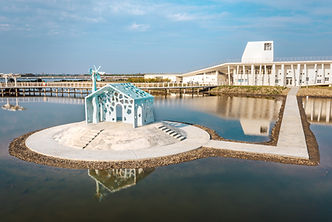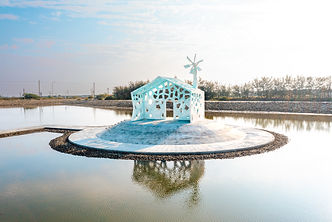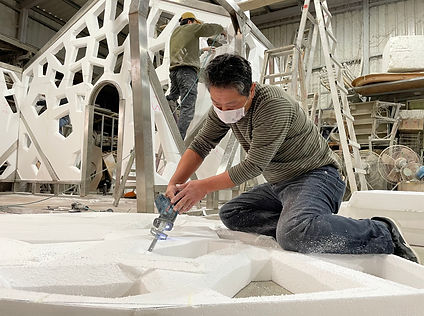
六號小島
Island No.6
一段被海風傳來的故事
海洋中有著許多島嶼
其中女孩居住的六號小島
原本是一處生活自由的世界
有一天
果實大王佔了島嶼、海洋與日光
用來種植「慾望果實」
曾經漁農自足的小島
被改建成果實農場
女孩失去了自由
必須依附著農場辛勤勞動
後來果實需求越來越大
機械人取代了女孩
女孩被迫離開了小島
某天女孩回到六號小島
果實農場已不再運轉
僅餘下了舊舍和老風車
但島嶼、海洋與日光依舊存在
女孩畫下一張新的藍圖
重新尋找島嶼的自由與美好
再次展開新的旅程



七股遊客中心景觀池的裝置作品〈六號小島〉,其座落位置為舊七股南鹽區[1]的第六生產區,故以此命名。用以感謝曾經風光這片土地的鹽工們,也紀念七股作為臺灣鹽業廢曬的休止符。
故事裡的「慾望果實」意指你我再熟悉不過的「鹽巴」,鹽業在日治、國民政府時期以專賣治理,以工業用鹽為大宗,用以奠定國家的財稅基礎。故事的「女孩」指的是當時鹽工和沿海居民,肩負著果實的生產,在各時期國家的經濟發展控制下,七股沿海土地與生活方式被任意的左右著,如徵收魚塭去改闢鹽田、犧牲生活必需設施、機械化製鹽取代了鹽工的勞動等。在無從選擇的時代,鹽工人生如自海水提煉的鹽,又復歸於海,起落得無聲無形。[2]
〈六號小島〉開端的筆直步道,如同鹽工無從選擇的人生道路。島上佇立著不規則形破口的房舍與風車,影射著隨時代發展被遺棄的鹽田屋舍、龜裂的土盤,以及曾經立足田邊的鹽風車。昔日製鹽的要素風、日光、海水依然存在著,期望鹽工生命故事隨著〈六號小島〉的鹽風車吹送各地,讓人珍惜得之不易的自由與土地。同時〈六號小島〉也像一艘暫時停泊的船隻,或許有天小島會鬆開與步道的連結,決心向著海洋漂流遠去,消失在各種念想之中,讓被限制的各種生命再次追尋被遺忘的自由。
註解
[1] 七股南鹽區,南日本鹽業株式會社出資,昭和13年(1938)闢建並於昭和18年(1943)完工,簡稱新鹽區,區域涵蓋中寮、西寮、頂山、後港、馬沙溝等聚落。
[2] 「六號小島」的發想背景,取自日治時期1935年開闢七股鹽場至2002年鹽場廢曬之期間所發生的真實故事。參考文獻:〈鹽田曬玉細說從頭:七股鹽場職工口述歷史〉,許献平,2018。

A story sent to us by the sea breeze
There are many islands and islets in the sea
Among them, Island No. 6 on which a girl lived
Which once was a free world
But one day
The Fruit King occupied the island, the sea, and the sun
Using them to grow the “fruit of longing”
This small island where the fishermen and farmers lived self-sufficient
Was changed into a fruit orchard
The girl lost the freedom to live
And could not but rely on hard work in the fields
Over time the demand for fruit grew greater
And machines replaced the girl
And the girl was exiled from the island
One day the girl returned to Island No. 6
To find the orchard no longer operating
Seeing only old huts and windmills
Still, the island, the sea, and the sun went on
So the girl drew a new map
To find the freedom and beauty of the island
And open up a new road for a new journey

The Island No. 6 installation art of the Qigu Salt Field Tourist Service Center
[1] scenic pool is located in the 6th production of the old Qigu Salt Fields, hence the name “Island No. 6.” It is a form of gratitude to the salt workers of the past who worked in these fields; it is also a memorial to Qigu as a symbol of the retired salt fields of Taiwan.
In the story recounted above, the “fruit of longing” is a symbol for the salt that you and I are so familiar with. The salt industry was run as a monopoly during the Japanese occupation and when the Nationalist government entered Taiwan, and industrial salt was used to lay the foundations for Taiwan’s finances and taxation. Then, the “girl” represents the salt workers and the coastal peoples who were tasked with the production of the “fruit”. As the country’s economic development was variously controlled in different periods, the Qigu coastal lands and lifestyles suffered arbitrary control, which included expropriating fish farms for reformation into salt fields, sacrificing the necessities of life, and mechanizing salt production which in effect replaced salt workers. In an age without choice, the salt workers were created like the salt being gleaned from the sea, and so they return to the sea, rising and falling without sound or sight. [2]
The unswerving walking trail at the beginning of Island No.6 could be said to resemble the life that salt workers lived—straight and without choice. Houses and windmills remain—though worse for wear—standing on the island, reminding one of the abandoned salt panning houses, cracked salt flats, and salt windmills that once stood on the field’s edge. But the simple and basic elements of salt production—wind, seawater, sunlight—exist now as then. Thus, it is hoped that the stories of the salt workers’ lives will fly on the winds to the four corners of the world with the salt windmill on Island No. 6, and from there, allow people to cherish this land and freedom, both hard-gotten gains. Island No. 6 is akin to a moored ship; though perhaps the island will one day unmoor itself from its past trail, and set itself to drift toward the ocean, disappear in thoughts, and put the wind back in the sails to yet again pursue forgotten freedoms.
• annotation •
[1] The Qigu salt production area was run with the funding of the South Japan Salt Industry. Expansion began in the 13th year (1938) of the Shōwa, which was completed five years later (1943). Called the New Salt Area, it included the areas of Zhongliao, Xiliao, Dingshan, Hougang, and Mashagou.
[1] The conceptual origin of Island No. 6 is the real story from the development of the Qigu salt area during the Japanese occupation in 1935 to its eventual abandonment to nature in 2002. Reference: The Story of the Salt Fields of Taiwan: An Oral History of the Qigu Salt Fields as Told by Salt Workers, Xu Xian-Ping, 2018.







• 六號小島 施作過程 •







六號小島 紀錄影片
設置單位 \ 交通部觀光署雲嘉南濱海國家風景區管理處
設置地點 \ 七股遊客中心
藝術設計 \ 陳昱良X有村藝術
整合施作 \ 大圭雕塑X禾田景觀設計有限公司
影 像 \ 探索星球影像工作室、廖毅宸
參與人員 \ 李佳蓉、余德柔、林靖容、張景昌、張雅雄、黃詠純、廖毅宸、陳碧芬、魏婉如
